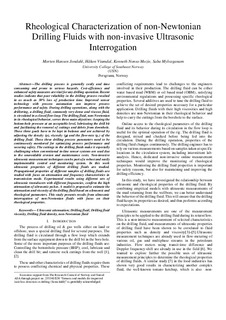| dc.contributor.author | Jondahl, Morten Hansen | |
| dc.contributor.author | Viumdal, Håkon | |
| dc.contributor.author | Mozie, Kenneth Nonso | |
| dc.contributor.author | Mylvaganam, Saba | |
| dc.date.accessioned | 2018-01-10T13:34:32Z | |
| dc.date.available | 2018-01-10T13:34:32Z | |
| dc.date.created | 2017-11-13T12:09:54Z | |
| dc.date.issued | 2017 | |
| dc.identifier.citation | Proceedings - IEEE Ultrasonics Symposium 2017, INSPEC Accession Number: 17350818 | nb_NO |
| dc.identifier.issn | 1948-5719 | |
| dc.identifier.uri | http://hdl.handle.net/11250/2476798 | |
| dc.description.abstract | The drilling process is generally costly and time consuming and prone to serious hazards. Cost-efficiency and enhanced safety measures are vital for any drilling operation. Recent studies indicate that poor reliability in the drilling process resulted in as much as 30% loss of production time. Improved sensor technology with process automation can improve process performance and safety. During drilling operations, along with the drillstring, a drilling fluid, commonly very dense and viscous fluid, is circulated in a closed flow-loop. The drilling fluid, non-Newtonian in its rheological behavior, serves three main objectives: keeping the bottom-hole pressure at an acceptable level, lubricating the drill bit and facilitating the removal of cuttings and debris from downhole. These three goals have to be kept in balance and are achieved by adjusting the density (ρ), viscosity (μ) and the flow-rate (qv) of the drilling fluid. These three drilling process parameters need to be continuously monitored for optimizing process performance and securing safety. The cuttings in the drilling fluids make it especially challenging when conventional in-line sensor systems are used due to the unavoidable erosion and maintenance costs. Non-invasive ultrasonic measurement techniques can be part of a robust and easily implementable control and monitoring system. In this work ultrasonic properties of different drilling fluids are studied. Propagational properties of different samples of drilling fluids are studied with focus on attenuation and frequency characteristics in transmission mode. Experimental results using different sets of ultrasonic transducers with different frequencies, confirm the high attenuation of ultrasonic pulses. A model is proposed to estimate the attenuation and viscosity of the drilling fluid based on ultrasonic and rheological parameters. This study presents results from ultrasonic interrogation of non-Newtonian fluids with focus on their rheological properties. | nb_NO |
| dc.language.iso | eng | nb_NO |
| dc.title | Rheological characterization of non-Newtonian Drilling Fluids with non-invasive Ultrasonic Interrogation | nb_NO |
| dc.type | Journal article | nb_NO |
| dc.type | Peer reviewed | nb_NO |
| dc.description.version | acceptedVersion | nb_NO |
| dc.rights.holder | c. ieee | nb_NO |
| dc.source.volume | 2017 | nb_NO |
| dc.source.journal | Proceedings - IEEE Ultrasonics Symposium | nb_NO |
| dc.identifier.doi | 10.1109/ULTSYM.2017.8092555 | |
| dc.identifier.cristin | 1513428 | |
| dc.relation.project | Norges forskningsråd: 255348 | nb_NO |
| cristin.unitcode | 222,58,2,0 | |
| cristin.unitname | Institutt for elektro, IT og kybernetikk | |
| cristin.ispublished | true | |
| cristin.fulltext | postprint | |
| cristin.qualitycode | 1 | |
